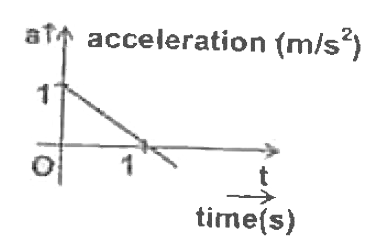Two particles P and Q start from rest and move for equal time on a straight line. Particle P has an acceleration of Xm/s2 for the first half of the total time and 2Xm/s2 for the second half. The particle Q has an acceleration of 2Xm/s2 for the first half of the total time and Xm/s2 for the second half. Which particle has covered longer distance ?
both have covered the same distance
P has covered the larger distance
Q has covered the larger distance
none of these
The correct Answer is:C
For P, in t sec.
x1=12Xt2=Xt22⇒v1=Xt
x2=(Xt)t+122Xt2⇒x2=2Xt2
xp=x1+x2=52X+2
For Q,
y1=12(2X)t2=Xt2⇒v2=2Xt
y2=(2Xt)t+12Xt2=52Xt2
yQ=y1+y2=72Xt2⇒yQ>xp.
Topper's Solved these Questions
- BOOK - A2ZCHAPTER - GENERAL KINEMATICS AND MOTION IN ONE DIMENSIONEXERCISE - AIIMS Questions20videos
GENERAL KINEMATICS AND MOTION IN ONE DIMENSION
- BOOK - A2ZCHAPTER - FLUID MECHANICSEXERCISE - Chapter Test29videos
FLUID MECHANICS
- BOOK - A2ZCHAPTER - GRAVITATIONEXERCISE - Chapter Test29videos
GRAVITATION
Similar Questions
Two particles A and B starts from rest and move for equal time on a straight line. The particle A has an acceleration a for the first of the total time and 2a for the second half. The particle B has an acceleration 2a for the first half and a for the second half. Which particle has covered larger distance?
View SolutionA particle is moving with a uniform acceleration 4ms−2 for time 2 second and then 5ms−20 for time 3 seconds. What is the average acceleration of particle during motion.
View Solution
Knowledge Check
- Question 1 - Select One
A body starts from rest and moves with constant acceleration for t s. It travels a distance x1 in first half of time and x2 in next half of time, then
Ax2=3x1Bx2=x1Cx2=4x1Dx2=2x1 - Question 2 - Select One
Starting from rest a particle moves in a straight line with acceleration
a=(25−t2)1/2m/s2 for 0≤t≤5s
a=3π8m/s2 for t>5s
The velocity of particle at t=7s is:A11 m/sB22 m/sC33 m/sD44 m/s - Question 3 - Select One
Two particles P and Q are moving on circle. At a certain instant of time both the particles and diametrically opposite and P has tangential acceleration 8m/s2 and centripetal acceleration 5m/s2 whereas Q has only e centripetal acceleration of1m/s2. At that instant acceleration (inm/s2) of P with respect to Q is
A14B√80C10D12
A body travels along a straight line for the first half of the total time with a constant speed of 20ms−1 and for the second half of the total time with a constant speed of 30ms−1 . Find the average speed of the body.
View SolutionA body travels along a straight line for the first half of the total time with a constant speed of 20ms−1 and for the second half of the total time with a constant speed of 30ms−1 . Find the average speed of the body.
View SolutionA particle starting from rest moves in a straight line with acceleration as shown in the a-t graph. Find the distance (in m) travelled by the particle in the first four seconds from start of its motion.
Q View Solution
View SolutionA particle, initially at rest, starts moving in a straight line with an acceleration a=6t+4m/s2. The distance covered by it in 3 s is
View SolutionA particle is moving in a straight line under constant acceleration of 4m/s2. If its velocity at t=0 is 10 m//s, the displacement of particle in the 5th second of its motion is
View Solution

